人教版七年级上册Unit4 公开课教案
- 格式:doc
- 大小:39.00 KB
- 文档页数:4

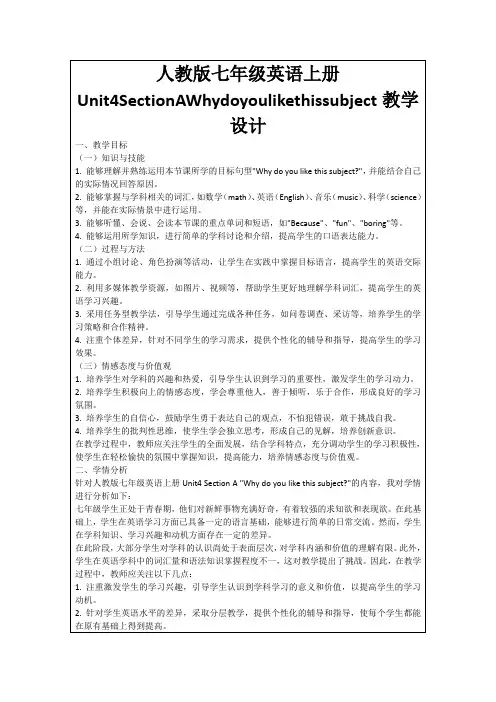
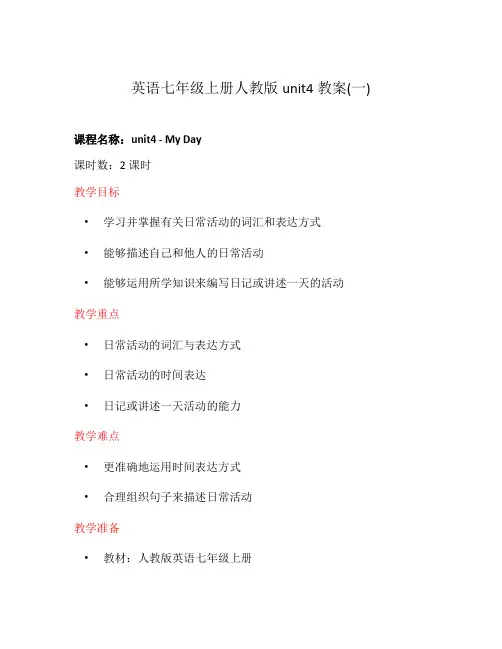
英语七年级上册人教版unit4教案(一)课程名称:unit4 - My Day课时数:2课时教学目标•学习并掌握有关日常活动的词汇和表达方式•能够描述自己和他人的日常活动•能够运用所学知识来编写日记或讲述一天的活动教学重点•日常活动的词汇与表达方式•日常活动的时间表达•日记或讲述一天活动的能力教学难点•更准确地运用时间表达方式•合理组织句子来描述日常活动教学准备•教材:人教版英语七年级上册•PPT或黑板•单词卡片或图片•学生练习册课程内容及安排第一课时词汇学习1.将课本P17页的单词及其图片呈现给学生,用图片引导学生猜测单词,然后教师读出单词并发音。
–wake up–get up–have breakfast–go to school–have lunch–do homework–have dinner–go to bed2.教师呈现图片,学生说出与图片相对应的单词。
进行多次训练,帮助学生记忆。
句型学习1.教师用日常活动的图片和单词介绍日常活动的句子结构。
–I wake up at 7:00.–He gets up at 6:30.–She has breakfast at 7:30.–They go to school at 8:00.2.强调句子结构中的时间表达方式。
教师解释常用的时间表达方式,如at 6:00、at 7:30等。
练习与拓展1.学生分成小组,根据所学词汇和句型制作一个日常活动的时间表。
每位学生描述自己的日常活动并说出时间。
2.小组展示自己的时间表,其他同学进行提问。
第二课时句型延伸与运用1.引导学生根据日常活动的时间表,编写一篇关于自己一天活动的日记。
强调使用所学的句型和时间表达方式。
日记分享与评价1.学生依次朗读自己的日记,并给予评价。
2.教师提供积极的反馈和改进建议。
课堂总结与反馈1.教师对上述学习内容进行总结,并检查学生对于日常活动词汇、句型及时间表达方式的掌握情况。
2.学生进行自我评价,指出自己的进步和不足之处。
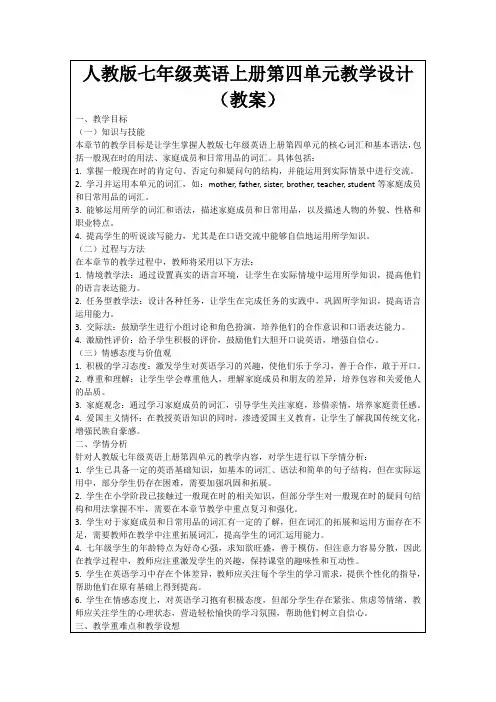
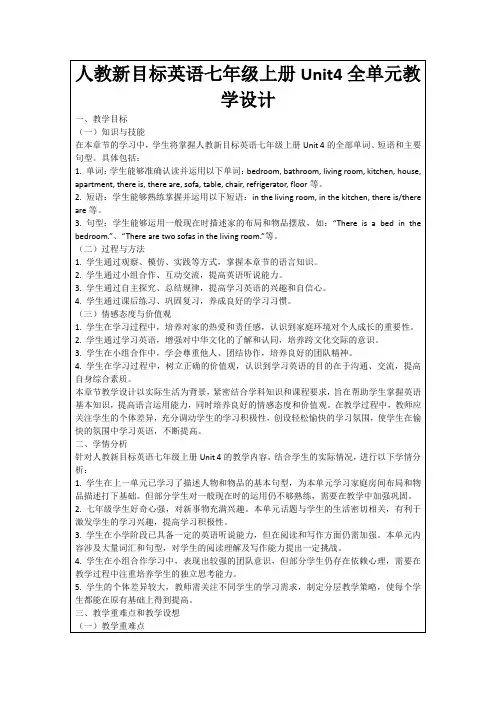
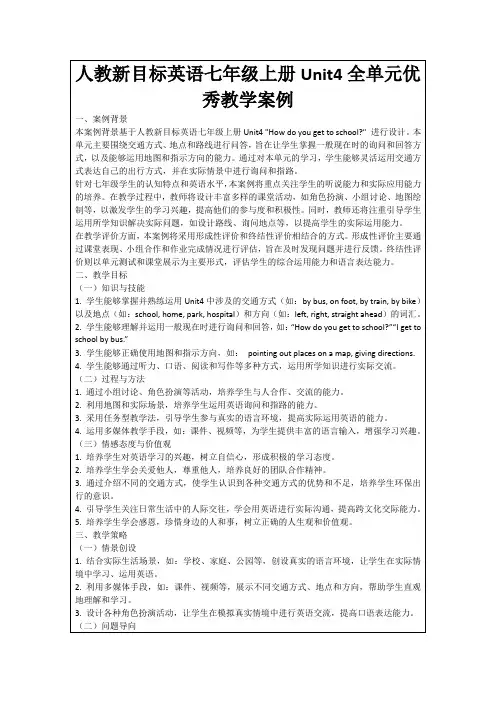
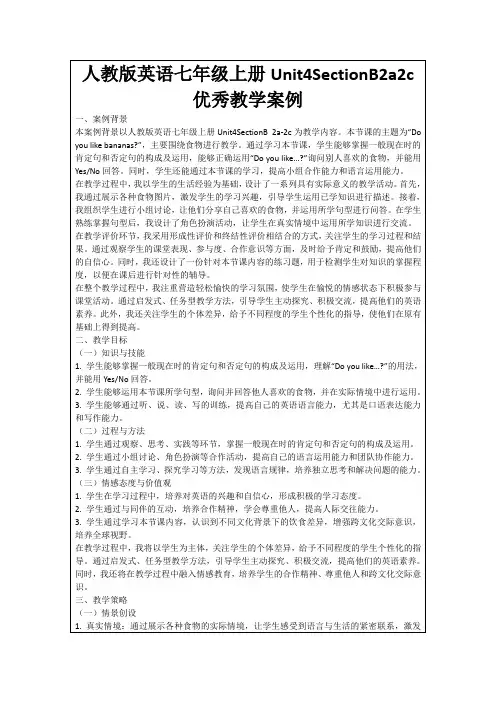
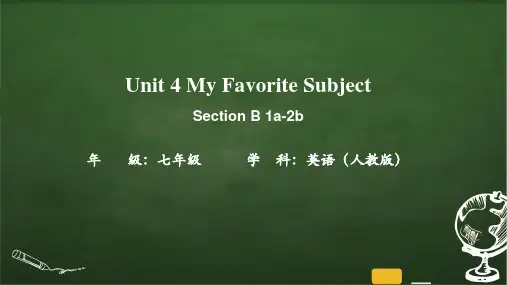
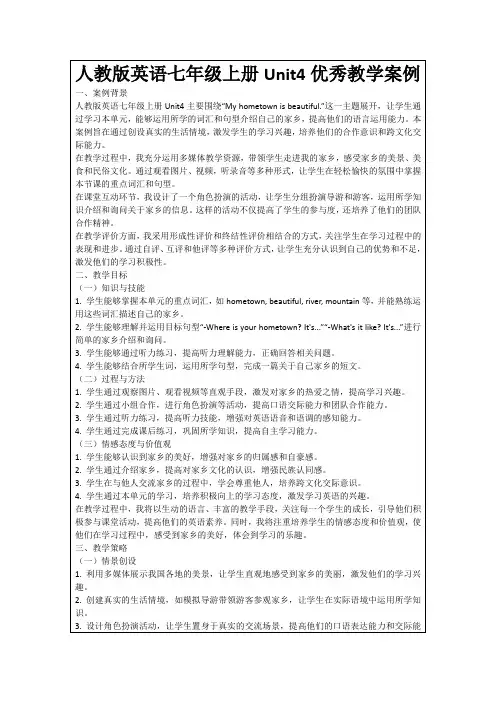
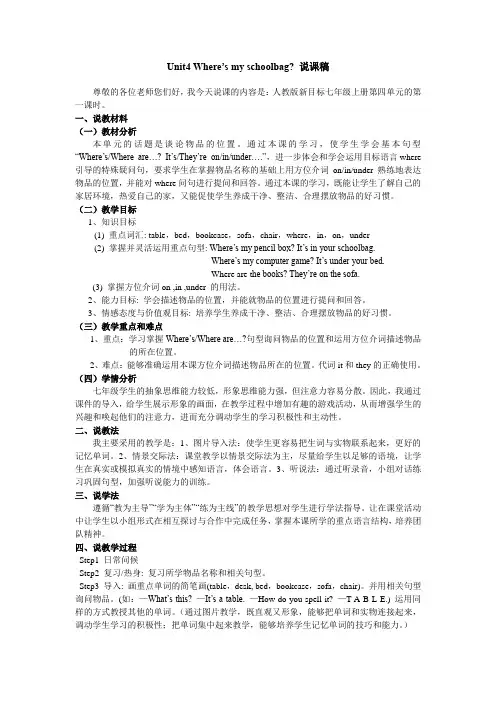
Unit4 Where’s my schoolbag? 说课稿尊敬的各位老师您们好,我今天说课的内容是:人教版新目标七年级上册第四单元的第一课时。
一、说教材料(一)教材分析本单元的话题是谈论物品的位置。
通过本课的学习,使学生学会基本句型“Where’s/Where are…? It’s/They’re on/in/under….”,进一步体会和学会运用目标语言where 引导的特殊疑问句,要求学生在掌握物品名称的基础上用方位介词on/in/under熟练地表达物品的位置,并能对where问句进行提问和回答。
通过本课的学习,既能让学生了解自己的家居环境,热爱自己的家,又能促使学生养成干净、整洁、合理摆放物品的好习惯。
(二)教学目标1、知识目标(1) 重点词汇: table,bed,bookcase,sofa,chair,where,in,on,under(2) 掌握并灵活运用重点句型: Where’s my pencil box? It’s in your schoolbag.Where’s my computer game? It’s under your bed.Where are t he books? They’re on the sofa.(3) 掌握方位介词on ,in ,under 的用法。
2、能力目标: 学会描述物品的位置,并能就物品的位置进行提问和回答。
3、情感态度与价值观目标: 培养学生养成干净、整洁、合理摆放物品的好习惯。
(三)教学重点和难点1、重点:学习掌握Where’s/Where are…?句型询问物品的位置和运用方位介词描述物品的所在位置。
2、难点:能够准确运用本课方位介词描述物品所在的位置。
代词it和they的正确使用。
(四)学情分析七年级学生的抽象思维能力较低,形象思维能力强,但注意力容易分散。
因此,我通过课件的导入,给学生展示形象的画面,在教学过程中增加有趣的游戏活动,从而增强学生的兴趣和唤起他们的注意力,进而充分调动学生的学习积极性和主动性。
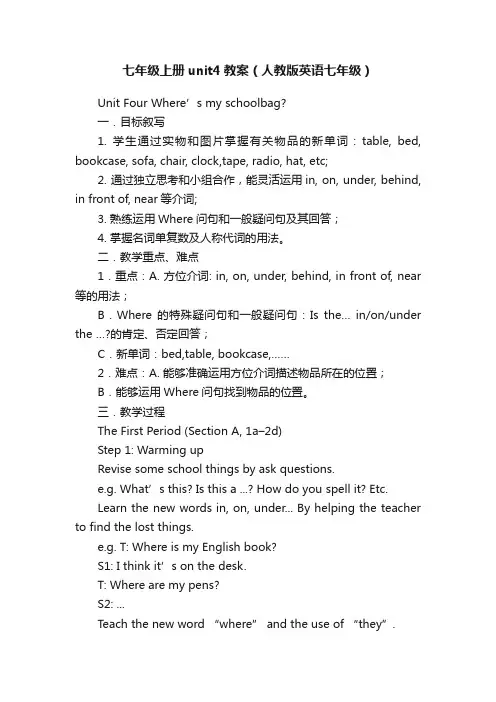
七年级上册unit4教案(人教版英语七年级)Unit Four Where’s my schoolbag?一.目标叙写1. 学生通过实物和图片掌握有关物品的新单词:table, bed, bookcase, sofa, chair, clock,tape, radio, hat, etc;2. 通过独立思考和小组合作,能灵活运用in, on, under, behind, in front of, near等介词;3. 熟练运用Where问句和一般疑问句及其回答;4. 掌握名词单复数及人称代词的用法。
二.教学重点、难点1.重点:A. 方位介词: in, on, under, behind, in front of, near 等的用法;B.Where 的特殊疑问句和一般疑问句:Is the… in/on/under the …?的肯定、否定回答;C.新单词:bed,table, bookcase,……2.难点:A. 能够准确运用方位介词描述物品所在的位置;B.能够运用Where问句找到物品的位置。
三.教学过程The First Period (Section A, 1a–2d)Step 1: Warming upRevise some school things by ask questions.e.g. What’s this? Is this a ...? How do you spell it? Etc.Learn the new words in, on, under... By helping the teacher to find the lost things.e.g. T: Where is my English book?S1: I think it’s on the desk.T: Where are my pens?S2: ...Teach the new word “where” and the use of “they”.Consolidate the prepositions by looking at the scree and answer the questions:Where’s...? Where’re...?Step2: PresentationLook and findT: Please look at the picture in activity 1a. There are some things in it. Do you know what they are?Match and discussa. T: Would you please match the words with the things in the picture?b. T: How many words do you know? Can you share the words you know with your partners?c. T: Please discuss with your partners and check whether your answers are the same.3.Check the answers4.ReadT: Please read the words after me. Table ...Step 3: Listen and numberT: Listen to the recording of 1b for the first time.T: Number the things in the picture when you listen to it for the second time.Read the sentencesa. T: I would like you to read the tape script together.b. T: Would you please read it by yourselves three times?Translate and explaina. T: Let’s translate the conversation into Chinese.b. T: Who can tell us what it means?c. T: Yes. When we ask the positions of things, we use the word “where”. And from the picture, we know that the word “on” means “在上面” “in” means “在里面” “under”means “在下面”. They are called prepositions “介词”。
Unit 4 Where’s my schoolbag?一、教材分析本单元围绕着Where is my schoolbag?的话题,共设计了三个部分的内容。
通过教授本单元,使学生学会谈论房间里物品的位置,能读懂有关物品位置的便条,并学会写便条让朋友帮自己从房间里取东西。
Section A 让学生通过活动,学习如何表达物品的位置,并能就物品位置进行提问。
1a, 1b, 1c 学习表示物品的名词,并能物品的位置进行问答。
重点运用where 特殊问句进行谈论。
二、三维目标1. Language goals:Key vocabulary: table, bed, bookcase, sofa, chair, where, on, under. Target language: Where’s my schoolbag? It’s under the table.Where are my books? They’re on the sofa2. Ability goalsTalk about where things are, Learn the using of preposition “ on, in, under”Train the students’ communicative competence.3. Moral goalsKeep your room and tidy.三、教学重点1、熟练运用Where问句和一般疑问句及其回答。
2.掌握名词单复数及人称代词they的用法。
四、教学难点一般疑问句Is it…? Are they…?的回答。
五、教学策略注重因材施教,对基础不同的学生,在开始阶段应有不同层次的要求,多鼓励,少批评,甚至不批评,以充分调动每个学生学习英语的积极性四、教学准备ppt ,多媒体课件等教学资料。
五、教学环节1、课堂导入students play a chantThis is a pen. These are pens.That is a book Those are booksIt’s a key They’re keys2、课堂讲授Learn the new wordsShow the pictures of the things on the screen.Teach the new words: chair, table, bed ,bookcase, sofa.(First, read the pronunciations , then read the words. Each word has the singular form and plural form.)Read the words over and over again until the students can name each item fluently.3、课堂练习exercise(用is/are填空)(1)Where _____ my schoolbag? (2) Where _____ my books?(3)Lily’s schoolbag ______ under the desk.(4) Tom’s books ______ on the sofa.(5)They ____ under the table. (6)It _____ a key4、课堂活动Work on 1aT: Turn to page 19, look at 1a. First read the words. Then look at the picture and look at the letters.Read the instruction. Students do 1a on their own.Check the answers.Read the words again.5、课堂小结采用“任务型”教学方法,遵循“任务”的递进原则,从单词到句型再到语法,逐步在设计教学活动,活动都有明确的目的和可操作性。
人教版七年级英语上册第4单元Unit4教案Unit 4 Lesson Plan for Grade 7 English (Textbook: People’s Education Press) Lesson Overview- Unit: 4- Textbook: Grade: 7- Subject: English- Duration: 1 week- Lesson Title: Unit 4Lesson Objectives- Develop the students' listening, speaking, reading, and writing skills in English- Enhance the students' understanding of basic grammar rules and vocabularyLesson ContentThis lesson will cover the following topics and activities:1. Vocabulary- Introduce and practice vocabulary related to daily routines, such as wake up, get dressed, eat breakfast, go to school, etc.2. Listening- Listen to audio recordings of different daily routines and identify the corresponding activities3. Speaking- Practice speaking about personal daily routines and ask and answer questions about others' routines4. Reading5. Writing- Write a short paragraph describing a personal daily routine using the vocabulary and grammar learned in class6. Grammar- Review and practice the use of present simple tense in sentences related to daily routines- Engage in pair or group discussions about daily routines and exchange information8. Evaluation- Assess the students' understanding through quizzes, oral presentations, and written assignmentsLesson PlanDay 1: Vocabulary and Listening- Introduce the new vocabulary related to daily routines- Play audio recordings of different daily routines- Have students match the activities with the corresponding recordings- Discuss the correct answers as a classDay 2: Speaking and Reading- Practice speaking about personal daily routines in pairs or small groups- Introduce the reading passage about a teenager's typical day- Discuss the answers as a classDay 3: Writing and Grammar- Review the present simple tense and its usage in sentences related to daily routines- Provide a writing prompt asking students to describe their own daily routines- Have students write a short paragraph using the vocabulary and grammar learned- Divide the class into pairs or small groups- Assign each group a set of questions related to daily routines- Have the groups discuss the questions and exchange information - Assess the students' understanding through oral presentations and participationResources- Textbook: People's Education Press Grade 7 English- Audio recordings of daily routines- Reading passage about a teenager's daily routine- Writing prompts for students to describe their daily routinesAssessment- Quizzes to test vocabulary knowledge- Evaluation of written paragraphs describing daily routines- Oral presentations and participation in group discussionsConclusion。
Unit 4 –Where’s my schoolbag?
Section A 1a-1c
---Make by···Background information:
Students:57 junior high school students, Class 6, Grade 7
Gender: 29 boys; 28 girls
Ages:14 years old
Lesson duration: 40mins
Teaching objectives:
Knowledge objectives:
1) Grasp the words about the furniture, such as table, chair, sofa and so on;
2) Grasp some sentences to describe the positions of the things
Ability objectives:
1) learn to asking the location of the object and confirm the position;
2) use the sentences to have a little talk about the things’ position.
Important points:
1)learn some words of furniture
2)Learn the usage of some direction prepositions, such as in, on, under;
Difficult points: How to use the direction prepositions and where sentence talk about the right position of things.
Teaching contents:
New words: table, chair, bookcase, bed, desk, in, on, under, where
New sentences:
1)Where is .....? It is on/ under/in/....
2)where are .....? They are .....
Teaching aids: blackboard, chalk, multimedia, paper, pictures.
Teaching procedures:
Step1 Review
1.(Prepare some school things.) Talk with individual S to reviewing the following English: What’s this?/It’s a(n)…/Is this(that) your…/Yes, it is. It’s mine./No, it isn’t. It’s his/Are these(those) your…?/Yes, they are. They’re mine./No, they aren’t. They’re hers.
T: What’s this? (There is a pen in the teacher’s hand.) S1: It's a pen.
T: Is this yours? S1: Yes, it is.
T: OK. Here you are. Now pay attention to this, these are his/her books. Are these your books?
S2: No,they aren’t.They’re his/hers. T: Excellent.
(Hold up a pen, an erase, some books and so on. Ask the questions in the same way.)
Step2.Lead-in( New words)
1. Prepare some pictures about furniture, ask the whole class “What’s this” and teach Ss to read the new words, such as bookcase, sofa, table, chair, bookcase, bed.etc.
2. Ask several Ss to read and spell the new words.
3. Play a game (High and Low V oice)
Step3. Presentation
1. Let Ss know the meaning and usage of some direction prepositions(in/on/under).
2. To describe the positions of the things in classroom, such as:
T: Where is my book? It’s on the desk. (Put a book on the desk.)
S1: It’s on the desk.
T: Where is my pen? It’s in the pencil case. (Put a pen in the pencil case and ask.)
S2: It’s in the pencil box.
T: Where is my schoolbag? (Put a schoolbag under the desk and ask this question.)
S3: It's under the desk.
T: Where is my schoolbag? (To all the students)
S s: It’s under the desk.
(Write "in, on, under" on the blackboard. )
3. Do an exercise ( Look and Say)
a. Where’s the pencil? / It’s on the table.
b.Where’s the schoolbag? / It’s under the table.
c. Where’s Tony? / It’s in the box.
d. Where are the books? / They’re in the bookcas
e.
e. where’re the keys? / They’re under the chair.
Step4. Consolidation
1. Work on 1a.
Now let's look at the picture in 1a. Match the words with the things in the picture.
2. Check the answers with the class.
3. Listening
a. Let Ss listen to the tape and finish 1
b.
b. Check the answers with the class.
Step5. Dill
1. Pair work
1c Practice the conversation in 1a with your partner. Then make your own conversations using the words in the box (in/on/under).
2.Exercise
1、Where ___(be) the books ?They’re _____ the _____
2、Where’s the computer game? It’s _____ the _____.
3、Where ___ (be)the schoolbag ? _______ on the ______.
4、Where’s the _____? It’s ___ the sofa.
5、Where ___ (be)the keys ? _______ ______the pencil box.
Step6.Summary
1. Grasp the words about the furniture and the direction prepositions
2. Grasp the sentences:
Where’s my pencil box?-It’s in the schoolbag.
Where are my books?-They’re on the sofa
Where’s my computer game?-It’s under the bed.
Step7.Homework
1. Use in/on/under to make the sentences.
2. Preview Section A 2a-3c (P20-21).。